
| Date of Start of Project | 10th February 2017 |
| Date of Completion of Project | 1st April 2017 |
| Location of the Project | Chennai, Tamil Nadu, India |
| Organization | St. Joseph’s Institute of Technology |
| Project Name | Investigation Analysis of Reducing Drag Force on Passenger Car |
| Designation & Role | Mechanical Engineer |
[CE 3.1]
This career episode describes my project bearing title “Investigation Analysis of Reducing Drag Force on Passenger Car’’. This project was carried out to fulfill the requirement of Mechanical Engineering Degree completion.
[CE 3.2]
A few years back when the fuel crisis was not a problem, cars were mainly designed for high-speed maneuverability, comfort, and safety. However, since 2002 with the recent impact of increasing fuel prices the decreasing sales of automobiles have crippled the industry all over the world. This was immediately followed by many questions raised regarding the effect of oil supply shortage on the future of this industry. Numerous resolutions were undoubtedly recommended and countless non-practical resolutions were now assumed thoughtful deliberation. Also, the advancement of electric cars and fuel-cells, other projected methods comprise the incorporation of air-conditioning systems with electronic devices to cut down energy consumption, the redesign of car frames and bodies to reduce the total weight, and the alteration of car physiques to progress the complete aerodynamic physiognomies for better-quality journeying circumstances, dependable triangulation and inferior-energy feasting. These enhancements are also indirectly related to the environment and noise pollution.
In the process of car enterprise, the aerodynamic-smoothness needs to be utterly worked upon. Vehicle design can, usually, only be satisfactory if its drag is abridged to a set mark. Numerous investigators have used CFD methodology to achieve arithmetical replications linked to vehicle-aerodynamics.
This project presents the development process of aerodynamic-holography of the automobile external frame. I performed numerous arithmetical simulations to analyze the pressure, velocity vector field & aerodynamic force forecasting associated with the passenger car. Then, I examined the steadiness of the aerodynamic forces caused by the airflow over the car. Thereafter, I prudently assessed the installation of additional instruments that move way to inferior aerodynamic-drag. Through FLUENT this work implied the 𝑘-𝜀-turbulence-model in a stable position flow to calculate the flow-field about the car and its additional instruments.
As a matter of fact, it is very uncommon to use 𝑘-𝜀 turbulence model in an iteration-dependent problem. Though, it was the goalmouth of this project to prove the viability of assimilating this rare tactic in this type of computational model. Within a relatively short amount of time, this computational process can estimate the aerodynamics of a car with high accuracy.
[CE 3.3]
The main objective of our project was as follows -
This project proposed an effective numerical model using the Computational Fluid Dynamics (CFD) to obtain the flow structure around a passenger car with different add-on devices. I built the computational / numerical model of the passenger car and mesh implying A.N.S.Y.S- Fluent which is the C.F.D-solver and was employed in the present work. In this project, I completed the numerical iterations and then aerodynamic data and detailed complicated flow structure were visualized. I developed a model of generic passenger car using solid works, and applied the boundary condition in ANSYS workbench platform, and then testing and simulation were achieved for the appraisal of drag-coefficient for vehicle. In addition to that, the aerodynamics of the most suitable design of vortex generator (VGs), spoiler, tail plate, and spoiler with VGs were introduced and analyzed the evaluation of drag constant for private car. The accumulation of these additional instruments lessens the drag-coefficient and lift-coefficient in colliding airstream. Circumnavigating the edges somewhat abridged drag in colliding airstream but does not bring about the significant improvements in the aerodynamic efficiency of the passenger car with add-on devices. Hence, the drag force can be reduced by using add-on devices on vehicle, also fuel economy and firmness of a private car can be enhanced meaningfully.
[CE 3.4]
This profound project was completed along with two other team members.
The project Hierarchy is given below -
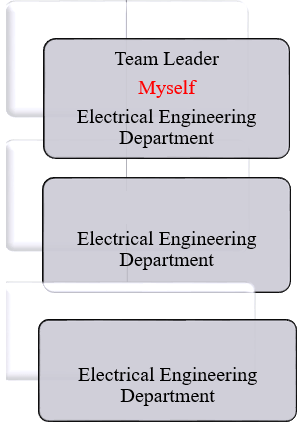
[CE 3.5]
I handled all the management related aspects of the project. I managed the reporting of the project progress to be presented to the project supervisor on fortnight basis. I also prepared the project final report and got it passed acceptably from project supervisor.
[CE 3.6]
It was evident for me and team to search for the work done in this subject of the project. We did offline search and made use of the university central library. We also serached online and gathered numerous papers and journals to study toroughly.
[CE 3.7]
My Roles & Responsibilities -
I also presented the project work plan as following -
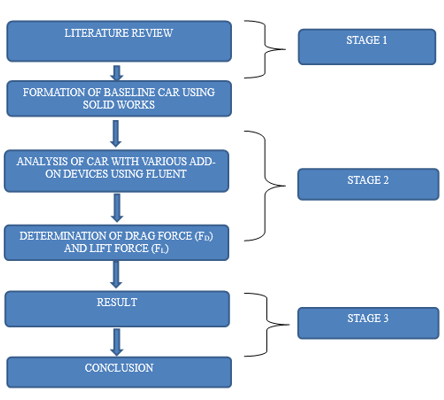
[CE 3.8]
In this project I first prepared a generic model of the passenger car in the Solid works software and this generic model was imported into the A.N.S.Y.S C.F.D to do the simulation of the coefficient of drag and coefficient of lift which is generated in the design module of the ANSYS FLUENT.
After this I generated the meshing on the surface of the passenger car. Aerodynamic assessment of airflow over an article were achieved by implying analytical technique or C.F.D method. Analytical technique of resolving air-flow over an article can be done only for modest flows over modest geometries. If airflow gets complex as inflows over a bluff-body, the flow develops turbulent and it is unbearable to resolve Navier-Stokes and steadiness equations systematically. In order to come up with reasonable solution I used a time-averaged Navier-Stokes equation along with turbulent-models to solve the glitch encompassing Reynolds stress resulting from the time averaging process.
In the present work the I selected 𝑘-𝜀 turbulence-model with non-equilibrium wall function to analyze the flow over the generic passenger car model. This 𝑘-𝜀 turbulence model is very robust, having reasonable computational turn-around time, and widely used by the auto industry.
I as a team leader defined the steps involved in the simulation -
[CE 3.9]
I designed the model of generic passenger car in solid works. Below figure shows the isometric view of the generic passenger car used in the present CFD simulation. The full size of the generic passenger car was 220mm long, 100mm wide and 90mm high. Thereafter, this model has been analyzed for drag constant and lift coefficient under the ANSYS (FLUENT) module.
The superficial-mesh of general passenger-car is displayed in below Figure. The tetrahedrons type meshing was produced on its surface. A surface-mesh of active full size is created on the vehicle surface.
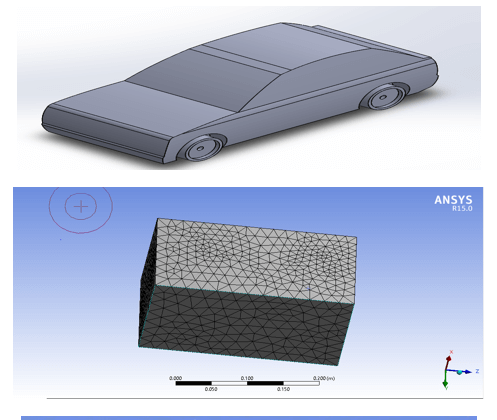
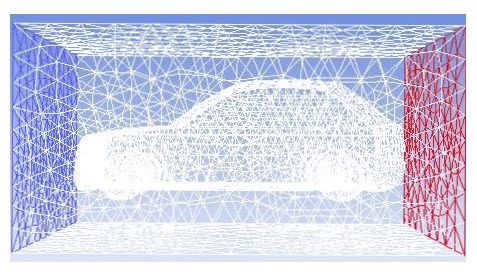
[CE 3.10]
Below pictures shows the velocity contour and number of velocity path lines on surface of baseline model passenger car. It also shows the maximum and minimum velocity occurred on the surface of the baseline model of passenger car.
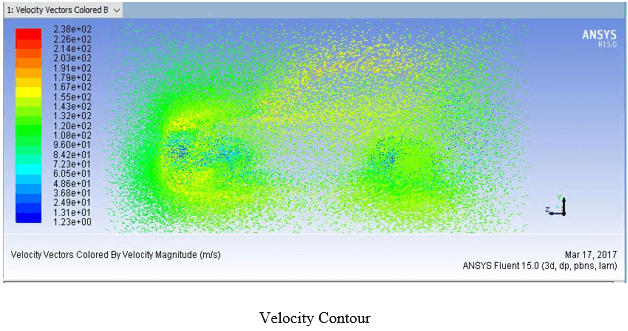
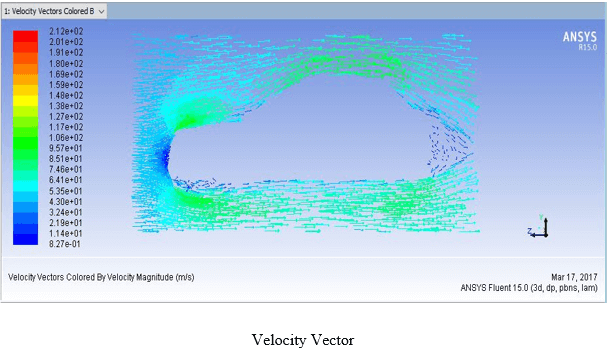
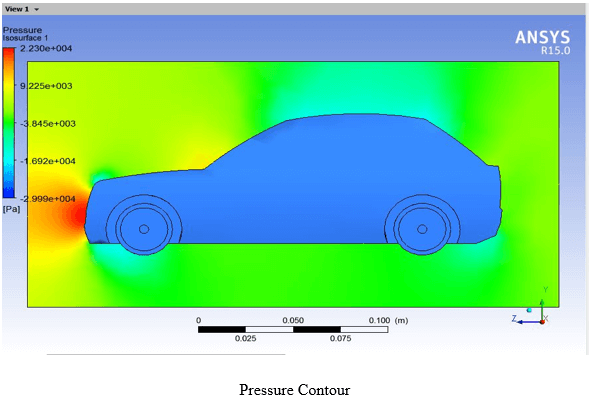
[CE 3.11]
The project played noteworthy role in my academic years.. I gained a lot of practical knowledge about the solid works and 3D simulations.
I presented along with the team the Computational fluid dynamics (CFD) simulations of the stable flow-field round passenger vehicle along with or without additional devices comparing the simulated data to each other. The A.N.S.Y.S Fluent with the 𝑘-𝜀 steady model was used by us for the simulations of aero dynamics. In this analysis, the coefficient of drag was reduced up to 84.75% and coefficient of lift was reduced up to 4.43% by the addition of spoiler setup. Hence, the spoiler setup was the effective add-on device to reduce the drag force on vehicle.
The effects of different aerodynamic add-on devices on flow and its structure over a generic passenger car can be analyzed using CFD tactic. The objective was to decrease aerodynamic- drag interim on the car and thus elevate the fuel efficacy of vehicle. Henceforth, the drag-force can be reduced by using add-on devices on vehicle. So, the fuel economy and steadiness of a passenger car can be enhanced.
We hold the apex position in providing services regarding CDR writing for engineers Australia. We are known to have very high success records for consistent team of professional writers having years of experience in the field of CDR preparation. We provide the best and trusted service for CDR writing and reviewing of all kinds of engineering disciplines. We provide services for career episode writing, plagiarism check and removal etc.
Should you need any further information, please do not hesitate to contact us.
Contact: +61-4-8885-8110
WhatsApp: +61-4-8885-8110
(Australia, USA, UK, UAE, Singapore, New Zealand)